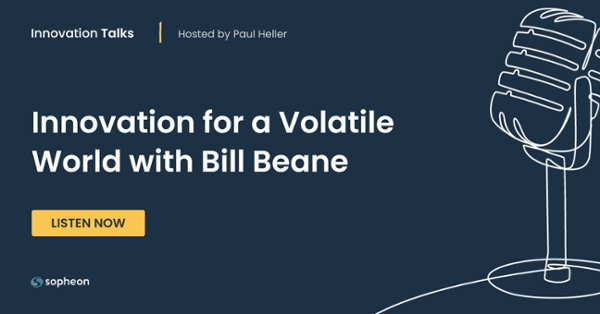Solving customer challenges should always be the North Star of any innovation plan. Bill Beane understands this concept better than anyone. As the Senior Director of Parker Technology Center and Innovation Systems at Parker Hannifin, Bill is responsible for helping to guide innovation to maintain the company’s status as a global leader in motion and control technologies.
I had the privilege of talking to Bill on an episode of the Innovation Talks podcast. He offered his unique thoughts on how organizations must put customer considerations first and build solutions second. Here are some of his insightful ideas on creating a customer-centric innovation plan.
Combining high-tech innovation with customer challenges
Far too often, companies base their innovation plans around the high-tech innovation they produce, then look for a customer problem to solve. Not to discount the amazing work that developers and engineers do, but in the world of product development, cool tech that doesn’t take a customer’s journey into account often leads to red ink at the bottom line.
Early in Bill’s career, he learned that the ‘tech first, customer second’ model wasn’t sustainable, noting, “We [had] a certain type of product, a certain type of technology, but trying to lead with technology or push this technology seems to have limited effectiveness. So we as a company went through a pretty serious transition of getting better aligned with what our customers are doing. We needed a better line of sight to what their challenges and issues were.”
As we all know, innovation requires arduous research and meticulous relationship-building with customers to uncover that ‘sweet spot’ of problems th organization can build disruptive products around. During our conversation, Bill popointedut that Parker Hannifin used rigid back-end methodologies to “keep the trains running on time” but needed more flexibility to allow early-stage innovation elements to thrive.
“We had too many technical ideas, and inside-generated ideas that weren’t chored in a market pull. Looking for a way to improve the front end of our process…we implemented segmentation to select the customer, the application, and the jobs to be done that you want to orient around. Then, we took on the process of talking to customers to get their observations.”
Moving customer-first offerings forward
Once you’ve identified a solvable customer challenge, you often face another tall hill to climb: customer buy-in. While you’ve identified a legitimate problem that a customer needs to be solved, convincing them that your solution will solve it isn’t always easy. As Bill shares, it comes back to clearly understanding who the customer is and the value your technology brings to the table.
“You tend to lead from where you’re comfortable since you know your technology inside and out. Perhaps you’re excited and passionate about your technology. That’s good,” Bill points out. “It’s a wonderful attribute to have, but you need to convey that to your customer in a way that gets them excited and engaged. Typically, it’s hard for customers to answer the question, ‘What’s in it for me?’ unless you’ve got more line of sight into what they’re struggling with and challenged by. If you can connect your deep technology to their clear and compelling want or need, then there’s magic.”
Bill reinforces this point by sharing insight he garnered from Bill Aulet, Managing Director of the Martin Trust Center for MIT Entrepreneurship and Professor of the Practice at the MIT Sloan School of Management, noting that it helps to think of innovation as a formula.
“Innovation is the product of invention multiplied by commercialization. As good as we are at invention and as capable as our technology may make us, if you multiply that by little or no commercialization, you still have nothing worth discussing. Whatever ideas you may have had better be tied to an improvement for a situation that’s out there in the market, or you’re back to trying to do everything on the back of technology. It’s not as effective an approach.”
Innovation plans aren’t easy to develop in the first place. But they become even more complex when customer challenges and needs aren’t at the center. By continuously and proactively listening to customers, you can develop products that remain ahead of the technological curve while effectively making their lives easier.
The results for Bill and Parker are impressive. Parker’s stock price growth accelerated as they made the changes Bill spoke about in what became their Winovation strategy, and today Parker is well respected as an innovative company among their peers in the industry.
Listen to my full conversation with Bill Beane on the Innovation Talks podcast.










